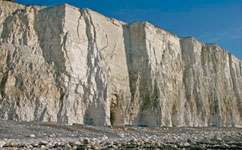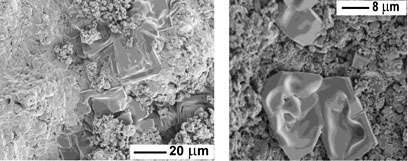Salt plays a greater role in undermining chalk cliffs than previously thought, say scientists. Until recently, if a chalk cliff collapsed it was blamed on waves eroding its base, or the chalk weakening as it became saturated with water. But in Brighton in 2001 a cliff behind a seawall that protected it from these processes began to collapse, and scientists questioned why.
'These cliffs behind the sea walls have been stable for 60 to 70 years so we wanted to know why they are now collapsing,' says Dr James Lawrence, now at the University of Leeds, lead author of the study. 'We realised over that time large amounts of salt had penetrated the pores of the cliff and is degrading the chalk.'
Lawrence and a team of researchers from the University of Brighton and the British Geological Survey tested samples of chalk from cliffs in the UK and France. They then compared them with chalk from an inland quarry which had had no exposure to salt.
'We did index tests on the samples to find out their saturated moisture content and density and then we put them under the scanning electron microscope to look at their chalk matrix,' he explains. 'On the images we saw some really large cubic salt crystals forming in the coastal samples.'
These crystals form as seawater splashes into the chalk and then evaporates, leaving salt in the pores of the rock. The salt crystals grow, deforming the shape of the pores. This slowly disrupts the cliff's structure, eventually causing it to crumble.
'When we tested the coastal samples strength against the quarry samples they were between 20 and 55 per cent weaker,' explains Lawrence. 'So instead of having a strength of seven or eight megapascals it had been reduced to three or four.' By halving the strength of the cliff, the salt halved the amount of weathering it could withstand before collapsing.
The team then tried to recreate the salty coastal conditions by exposing the quarry rocks to accelerated weathering in the lab, to see if salt was the main factor behind the weakening. Once they had got the salt crystals in the quarry rock to the same size as they had been in the cliff samples, Lawrence tested the strength again.
'We were shocked to see the strength was exactly the same as the coastal cliff samples had been – it felt great when we realised amazing that the results were so similar ,' Lawrence says. This experiment proved salt is a major factor in cliff collapse and the researchers think this may mean large scale cliff failures will get worse with climate change.
'Climate change predicts sea-level rise – in fact we're already seeing a rise. With that and more storm surges you get more frequent waves and spray hitting cliffs. This means more opportunities for the salt water to get into chalk cliffs' pores. If that happens more over time we will see lots of new collapses along chalk cliffs in the future,' says Lawrence.
More information: Lawrence, J. et al. (2013) Sea saltwater weakening of chalk and the impact on cliff instability, Geomorphology In press.
Journal information: Geomorphology
Provided by PlanetEarth Online
This story is republished courtesy of Planet Earth online, a free, companion website to the award-winning magazine Planet Earth published and funded by the Natural Environment Research Council (NERC).





















